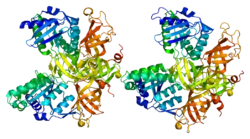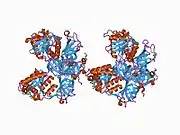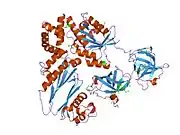| TUFM | |||||||||||||||||||||||||||||||||||||||||||||||||||
|---|---|---|---|---|---|---|---|---|---|---|---|---|---|---|---|---|---|---|---|---|---|---|---|---|---|---|---|---|---|---|---|---|---|---|---|---|---|---|---|---|---|---|---|---|---|---|---|---|---|---|---|
 | |||||||||||||||||||||||||||||||||||||||||||||||||||
| Identifiers | |||||||||||||||||||||||||||||||||||||||||||||||||||
| Aliases | TUFM, COXPD4, EF-TuMT, EFTU, P43, Tu translation elongation factor, mitochondrial | ||||||||||||||||||||||||||||||||||||||||||||||||||
| External IDs | OMIM: 602389 MGI: 1923686 HomoloGene: 2490 GeneCards: TUFM | ||||||||||||||||||||||||||||||||||||||||||||||||||
| |||||||||||||||||||||||||||||||||||||||||||||||||||
| |||||||||||||||||||||||||||||||||||||||||||||||||||
| |||||||||||||||||||||||||||||||||||||||||||||||||||
| |||||||||||||||||||||||||||||||||||||||||||||||||||
| |||||||||||||||||||||||||||||||||||||||||||||||||||
| Wikidata | |||||||||||||||||||||||||||||||||||||||||||||||||||
| |||||||||||||||||||||||||||||||||||||||||||||||||||
Elongation factor Tu, mitochondrial is a protein that in humans is encoded by the TUFM gene. It is an EF-Tu homolog.[5][6][7]
References
- 1 2 3 GRCh38: Ensembl release 89: ENSG00000178952 - Ensembl, May 2017
- 1 2 3 GRCm38: Ensembl release 89: ENSMUSG00000073838 - Ensembl, May 2017
- ↑ "Human PubMed Reference:". National Center for Biotechnology Information, U.S. National Library of Medicine.
- ↑ "Mouse PubMed Reference:". National Center for Biotechnology Information, U.S. National Library of Medicine.
- ↑ Ling M, Merante F, Chen HS, Duff C, Duncan AM, Robinson BH (Nov 1997). "The human mitochondrial elongation factor tu (EF-Tu) gene: cDNA sequence, genomic localization, genomic structure, and identification of a pseudogene". Gene. 197 (1–2): 325–36. doi:10.1016/S0378-1119(97)00279-5. PMID 9332382.
- ↑ Shah ZH, Migliosi V, Miller SC, Wang A, Friedman TB, Jacobs HT (Jun 1998). "Chromosomal locations of three human nuclear genes (RPSM12, TUFM, and AFG3L1) specifying putative components of the mitochondrial gene expression apparatus". Genomics. 48 (3): 384–8. doi:10.1006/geno.1997.5166. PMID 9545647.
- ↑ "Entrez Gene: TUFM Tu translation elongation factor, mitochondrial".
Further reading
- Wells J, Henkler F, Leversha M, Koshy R (1995). "A mitochondrial elongation factor-like protein is over-expressed in tumours and differentially expressed in normal tissues". FEBS Lett. 358 (2): 119–25. doi:10.1016/0014-5793(94)01403-N. PMID 7828719. S2CID 24769779.
- Woriax VL, Burkhart W, Spremulli LL (1996). "Cloning, sequence analysis and expression of mammalian mitochondrial protein synthesis elongation factor Tu". Biochim. Biophys. Acta. 1264 (3): 347–56. doi:10.1016/0167-4781(95)00176-x. PMID 8547323.
- Chang SY, Park SG, Kim S, Kang CY (2002). "Interaction of the C-terminal domain of p43 and the alpha subunit of ATP synthase. Its functional implication in endothelial cell proliferation". J. Biol. Chem. 277 (10): 8388–94. doi:10.1074/jbc.M108792200. PMID 11741979.
- Andersen JS, Lyon CE, Fox AH, et al. (2002). "Directed proteomic analysis of the human nucleolus". Curr. Biol. 12 (1): 1–11. doi:10.1016/S0960-9822(01)00650-9. PMID 11790298. S2CID 14132033.
- Strausberg RL, Feingold EA, Grouse LH, et al. (2003). "Generation and initial analysis of more than 15,000 full-length human and mouse cDNA sequences". Proc. Natl. Acad. Sci. U.S.A. 99 (26): 16899–903. Bibcode:2002PNAS...9916899M. doi:10.1073/pnas.242603899. PMC 139241. PMID 12477932.
- Blagoev B, Kratchmarova I, Ong SE, et al. (2003). "A proteomics strategy to elucidate functional protein-protein interactions applied to EGF signaling". Nat. Biotechnol. 21 (3): 315–8. doi:10.1038/nbt790. PMID 12577067. S2CID 26838266.
- Gevaert K, Goethals M, Martens L, et al. (2004). "Exploring proteomes and analyzing protein processing by mass spectrometric identification of sorted N-terminal peptides". Nat. Biotechnol. 21 (5): 566–9. doi:10.1038/nbt810. PMID 12665801. S2CID 23783563.
- Gerhard DS, Wagner L, Feingold EA, et al. (2004). "The status, quality, and expansion of the NIH full-length cDNA project: the Mammalian Gene Collection (MGC)". Genome Res. 14 (10B): 2121–7. doi:10.1101/gr.2596504. PMC 528928. PMID 15489334.
- Andersen JS, Lam YW, Leung AK, et al. (2005). "Nucleolar proteome dynamics". Nature. 433 (7021): 77–83. Bibcode:2005Natur.433...77A. doi:10.1038/nature03207. PMID 15635413. S2CID 4344740.
- Ahmed M, Forsberg J, Bergsten P (2005). "Protein profiling of human pancreatic islets by two-dimensional gel electrophoresis and mass spectrometry". J. Proteome Res. 4 (3): 931–40. doi:10.1021/pr050024a. PMID 15952740.
- Antonicka H, Sasarman F, Kennaway NG, Shoubridge EA (2006). "The molecular basis for tissue specificity of the oxidative phosphorylation deficiencies in patients with mutations in the mitochondrial translation factor EFG1". Hum. Mol. Genet. 15 (11): 1835–46. doi:10.1093/hmg/ddl106. PMID 16632485.
- Smeitink JA, Elpeleg O, Antonicka H, et al. (2006). "Distinct clinical phenotypes associated with a mutation in the mitochondrial translation elongation factor EFTs". Am. J. Hum. Genet. 79 (5): 869–77. doi:10.1086/508434. PMC 1698578. PMID 17033963.
- Valente L, Tiranti V, Marsano RM, et al. (2007). "Infantile encephalopathy and defective mitochondrial DNA translation in patients with mutations of mitochondrial elongation factors EFG1 and EFTu". Am. J. Hum. Genet. 80 (1): 44–58. doi:10.1086/510559. PMC 1785320. PMID 17160893.
- Ewing RM, Chu P, Elisma F, et al. (2007). "Large-scale mapping of human protein-protein interactions by mass spectrometry". Mol. Syst. Biol. 3 (1): 89. doi:10.1038/msb4100134. PMC 1847948. PMID 17353931.
This article is issued from Wikipedia. The text is licensed under Creative Commons - Attribution - Sharealike. Additional terms may apply for the media files.






